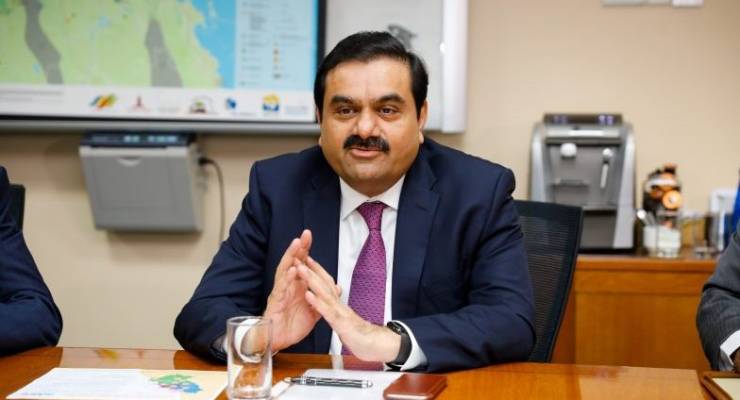
After nearly a decade of legal battles, bitter controversy and political backflipping, Gautam Adani finally has his mine. Last week, the federal government granted the final approvals for the huge mining project at Carmichael, in central Queensland’s Galilee Basin.
But despite its immense scale, the Carmichael mine was perhaps dwarfed by the outsized significance it took on in Australia’s increasingly fractured political debate, amid the steady reframing of climate change as a culture war issue.
Adani remains a colossal monument to a divided Australia. It symbolises the depths of the Coalition’s cult-like devotion to coal, and Australia’s indifference to the coming climate catastrophe. It lies at the heart of the irreconcilable chasm between the inner city, where Adani is a dirty word, and economically-depressed regional Queensland, where it represents the promise of some limited relief from a stagnant job market.
The early days
The mine began with little fanfare in 2010, when the Adani Group bought coal tenements off Linc Energy. It was a different time — Julia Gillard was prime minister, and while the fault lines over climate politics were growing deeper and wider, Australia was just a year away from getting a short-lived, but effective, carbon tax.
Still, there was considerable support for Adani in the early days. In 2010, Queensland premier Anna Bligh had promised to double coal production, and in October, just a month before making the first announcements about the mine, met with Gautam Adani on a trade junket to India.
A coal mine of this scale was always going to have tremendous environmental consequences, which started to crystallise not long after the project was first announced. In 2012, a Greenpeace report highlighted what that might look like — the mine would more than double Australia’s coal exports and would produce more emissions than half of Western Europe combined. The surrounding wilderness would be devastated, while developing a port to export material at Abbot Point would involve dredging 3 million cubic metres of waste into the Great Barrier Reef.
In response, politicians from across the aisle publicly reassured the mining industry about their commitment to coal’s future. Later that year federal resources minister Martin Ferguson (who is now a fossil fuel lobbyist) and Queensland premier Campbell Newman were being flown around India on Gautam Adani’s private jet, promising the billionaire that construction would begin by 2013.
As conservatives eventually rallied around Adani, painting it as a silver bullet to central Queensland’s jobs crisis, it continued to drive a wedge between Labor ranks. Many blamed the party’s mixed messages on the mine as key to its electoral failure in Queensland.
The legal battles
Seven years after Ferguson and Newman’s pronouncement, construction still hasn’t begun. A key reason for the delay is the constant legal challenges, which have successfully staved off the mine.
In 2010 Anna Bligh’s Queensland government designated the Carmichael mine a “significant project”, meaning it had to undergo a comprehensive environment impact assessment. A mine of this size required several approvals under both state and federal legislation. In 2014, Queensland gave the mine approval, subject to 190 conditions, with federal environment minister Greg Hunt giving his approval soon after.
But Hunt’s decision was subject to a successful Federal Court challenge brought by Mackay Conservation Group in early 2015, who showed that the minister had failed to consider the adverse impacts on endangered species. That decision showed just how divisive Adani was starting to become, with attorney-general George Brandis denouncing activists who brought the case as “vigilante litigants”. Meanwhile, the Queensland Land Court delivered a judgment recommending further environmental conditions.
The mine was also subject to Native Title litigation. Native Title legislation allows mining companies to negotiate an Indigenous Land Use Agreement with traditional owners in order to get an interest in land, a system described as “coercive” and “unbalanced”.
Adani is alleged to have meddled in negotiations with the Wangan and Jagalingou people, the traditional owners of the land in the Galilee Basin, stoking divisions within the community, and stacking meetings among the claim group to get a favourable result.
The subsequent ILUA has been subject to several appeals by Wangan and Jagalingou representatives. It’s validity was upheld by the Federal Court last year, with the traditional owners commencing an appeal before the full bench in May. Recently, Queensland’s environment minister Leeanne Enoch, who is the first Indigenous woman elected to Queensland parliament, said she was “devastated” about having to approve the mine against the wishes of the traditional owners.
And while construction is set to begin, successful legal challenges are still causing headaches for Adani, and last week, the Australian Conservation Foundation successfully appealed the government’s water assessment
Shrinking financial viability
But perhaps the biggest source of delay is the fact that the mine is not nearly as financially lucrative as once thought. Coal is simply not as profitable in 2019 as it was in 2010. As far back as 2015, Adani was struggling to get financial backers for its project, with Australia’s Big Four soon following suit. In response, Matt Canavan, whose devotion to the cult of coal is seemingly unshakable, told Queenslanders to boycott Westpac.
Meanwhile, India’s own appetite for coal was changing. It announced a plan to stop importing coal in 2016; by then solar panels were almost as cheap as coal.
Growing more desperate, Adani asked the government for a $900 million concessional loan, which Queensland vetoed. Last year, it was reported that Adani was getting some indirect government funding. The company was ultimately forced to self-fund the project, and abandon ambitious plans to build a billion-dollar rail link from its mine to the Abbot Point coal terminal.
Adani’s defenders also long-trumpeted the promise of of 10,000 new jobs. That number has consistently shrunk. In 2015, a former Reserve Bank economist contracted to crunch numbers for Adani estimated the project would provide just 1464 jobs. The company’s most recent estimates point to somewhere between 800 and 1500 direct jobs, and 6750 indirect jobs. The destruction of the reef, meanwhile, could destroy 64,000 jobs.
Gautam Adani’s decade-long battle to get his big mine has ended in a pyrrhic victory. It is unlikely to provide central Queensland with the economic transformation the Matt Canavans of this world insist that it will. And the financial picture is increasingly bleak — a recent article in Bloomberg suggested the company is losing $220 million a year.
Meanwhile, Adani remains best remembered as a symbol of division, and a gargantuan temple to Australia’s stubborn, myopic resistance to science.








Climate Change is an economic Issue, as well as a culture issue. The Great Barrier Reef is dying and a piddly, insignificant and microscopic $400 million is set aside to fix it. How do you fix Climate Change?
A piddling $400 million given to the wrong people …
Damn them all to the Eternal pits of a coal-fired Hell.
Unless he gets his pipeline, his railway & his insurance, then I doubt Adani’s project will move forward anyway.
It’s not just about Adani, there’s Palmer and Rhinehart and her partner China Resources to appease and assuage.
https://www.abc.net.au/news/2019-06-12/adani-approval-could-be-galilee-basin-ice-breaker/11194510
The is what is at stake.
The main beneficiaries of this mine will be the LNP & Queensland Labor. Both party’s campaign coffers will be refilled by the mining lobby within which members of both parties have well-placed “advisors”. In many other countries, this would be called bribery & nepotism.
It’s not built yet. They can’t get finance or insurance. Buyers for second its second rate coal aren’t certain either. And of course a train line.
A few piddling bits of site works keeps the vultures circling the troubled Adani Group at bay for a bit longer. No project means write downs not just on the mine lease but on the coal shipping terminal. A project still technically happening keeps billions alive on the balance sheet. It still looks like a house of cards.
A-G-R-E-E!
That seems to be the crux of it Mark. The odds are still stacked against the mine ever shipping anything. Only politicians doing cartwheels keep it in this zombie state.